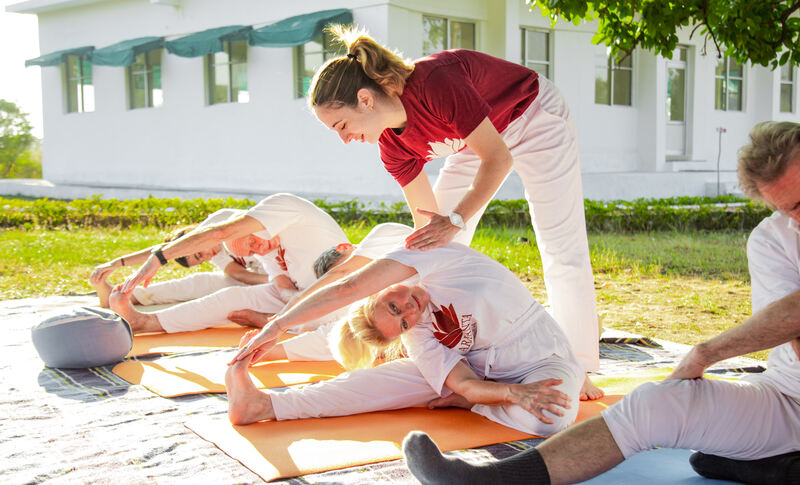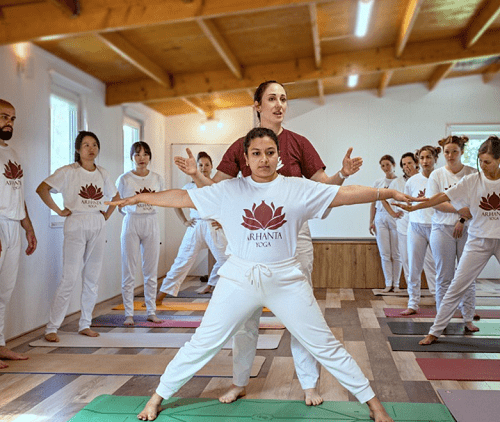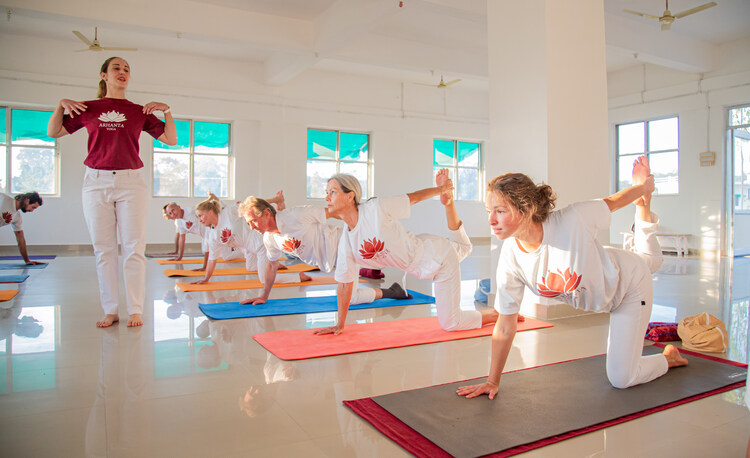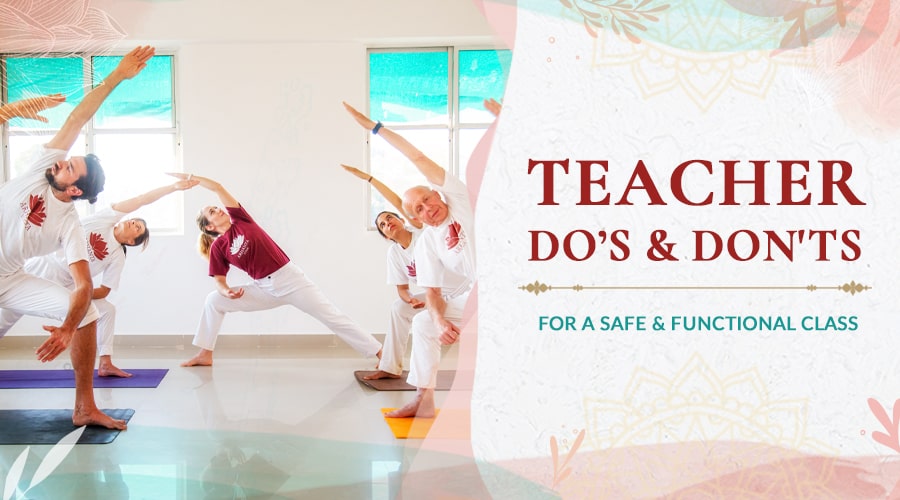Nowadays, many yoga teachers are obsessed with the outer shape and aesthetics of a pose. While alignment is important, focusing on this aspect alone in your yoga cues and adjusts doesn't allow our students to find their own natural form and rhythm in their practice. This rigidity can lower confidence on the mat, and in some cases, result in injury.
The truth is alignment is not a one-size-fits all concept. A certain pose will look and feel very different for each of us, depending on our skeleton shape, muscle tone, flexibility, and non-physical factors such as experience and state of mind. As teachers, it’s our responsibility to understand our students' limits and offer cues and assistance that encourages them to explore their practice with joy and safety.
If you're new to teaching yoga or are simply looking for some yoga cues to freshen up your class, this article will share my personal dos and don’ts, as well as a few techniques every teacher should have in their toolkit. By the end it, you will know:
- What yoga cues are and their importance
- The best way to cue poses in yoga
- How to adjust your students to increase comfort and accessibility
What Are Yoga Cues?

As yoga teachers, it’s our job to guide our students from simple to complex poses without providing too much intervention. One of the ways we do this is with descriptive yoga cues.
Yoga cues are verbal instructions or suggestions yoga teachers give during a class to help students better align their bodies, connect with their breath, and most importantly, modify poses to suit their individual needs. These cues are usually a mix of directional, anatomical, and sometimes metaphorical instructions, which we can categorise as:
- Postural cues: Step your right foot forward between your hands
- Alignment cues: Lengthen your spine to the sky
- Transformational cues: Focus on your breath, exhaling destructive thoughts from the day and inhaling positive ones
Also Read - How To Become A Certified Yoga Instructor
Why Are Yoga Cues Important for Teachers?
Often, when a student tries to fit into the picture-perfect alignment of a pose, they stress or even strain other parts of the body instead of working on the target area. Yoga cues are important as they help the student identify which part of the body they are working on, allowing them to adjust and modify to their specific needs.
Another reason we use cues in yoga class is to help students feel more comfortable and confident in the pose. This is the case when we help someone come into Headstand. By giving them the proper guidance and assistance, they naturally develop comfort and confidence in the pose.

Experience authentic Hatha Yoga
Get free access to exclusive guided lessons with master teacher Kalyani Hauswirth-Jain
Best Way to Cue Poses in Yoga: Dos & Don'ts for a Safe & Functional Practice

As mentioned above, yoga cues are simple verbal prompts we give our students to help them come into the pose, or sometimes mental state, we want them in. These handy phrases can be very effective, but it’s important to know when and how to use them. Below are a few yoga cue dos and don’ts for teachers that I’ve found provide a safe yet encouraging environment for students of all levels and abilities.
Postural Cues
Don’t Start with Complex Poses that Require Flexibility
Sometimes teachers cue the final or most complex version of a pose first and show the simpler version after. For poses that are achievable with focus and strength like Headstand, this can be a great way to motivate your students and show them what’s possible with regular practice and dedication.
However, this approach can have the opposite effect when teaching complex asanas that require flexibility. While some students are hypermobile, many aren’t, and not being able to achieve this level of flexibility, even with practice, can be incredibly demotivating and even dangerous. So, when cueing yoga poses, a good idea is to start simple and gradually move to more complex variations, especially in challenging asanas.
Do Give Demonstrations for New Poses
If the pose you are teaching is new, it’s important to demonstrate it to your students to show them how to come into the posture safely. There are some exceptions though. For common poses they would already be familiar with, like Savasana, this might not be unnecessary and could even bore some of your students.
You can either demonstrate the pose yourself or on another student if space allows, providing simple yet effective postural cues for each important movement.
Do Focus on Functionality
It can be difficult to decide which variation of a pose to cue first in your class. As mentioned above, giving postural cues for complex poses first can make some students feel inadequate or silence their body's natural movements. For me, the decision is easy when you focus on the functionality of the pose. This should be the most important factor when cueing yoga poses.
For poses that are slightly more complex, start with the basics and focus on how the pose should feel, not just look. When cueing yoga poses like Downward-Facing Dog, begin with knees slightly bent and encourage your students to lift the sit bones toward the ceiling and lengthen through the back body.
Once they have achieved this, you can offer the option to further straighten the legs if they feel confident enough in the position. Maintaining the pelvic alignment is a good way to cue from movements that are accessible into ones that require more flexibility. Remember to also provide modifications for students who might not be at that level yet.
Alignment Cues
Don’t Use Precise Cues
We’ve all heard (and used) yoga alignment cues like “tuck your tailbone” and “engage your core” in our classes. There’s nothing wrong with these prompts, but I’ve found that the overuse of cues that are too detailed like these actually provide little value for the student. For example, when students overarch their lower back in Warrior 2, many teachers would cue to tuck the tailbone, but this can result in students overcompensating and falling out of alignment in other areas.
The reason for this is that many practitioners, especially beginners, lack the anatomical knowledge and physical awareness to tense or release parts of the body at will. So, asking them to “engage their core muscles” can lead to more confusion. To avoid this, keep your alignment cues simple and think of how you would describe the movement with direction.
Do Target Direction of Movement
One of the best ways to cue complex alignments effectively is to focus on the direction of movement in a pose. When cueing yoga poses, think about the contrasting and complementary movements happening all at once — the direction of the feet pushing away from each other, pelvis sinking down toward the ground, while the head reaches up to the sky.
By creating a sense of direction and tension, we allow our bodies to discover their own natural alignment, developing a more intuitive understanding of muscle engagement and release. This approach not only helps students feel more connected to and aware of their bodies, but also promotes a healthy balance between the body’s natural form and what each pose is supposed to achieve.
Transformational Cues
Do Bring Awareness Inward
Transformational cues go beyond the physical aspects of yoga. They are about bringing practitioners into deeper states of awareness. Whether encouraging students to observe the ebb and flow of their breath, or feel the movement of energy flowing within, it’s important to give them the opportunity to direct awareness to different levels of the experience. Some of my personal favorite transformational yoga cues are:
- Breathe in healing, rejuvenating energy. Slowly breathe out, sending your breath to any spots of tension or pain.
- Be curious, like a researcher studying a fascinating phenomenon and observe your body, your breath, your thoughts…
- Allow yourself to be content with wherever you are in the pose. It is perfect just as it is.
Do Encourage a Deeper Connection
If your class is centered around a particular theme, like gratitude or grounding, weaving this theme into your yoga cues can be impactful. It allows students to express their emotions within their movements, leading to a deeper connection within their practice.
Encouraging students to set a clear intention for their practice can be beneficial as well. Whether it’s to conquer a difficult pose or to work through a personal issue, having an intention transforms the class into a space for contemplation and resolution.
3 Essential Physical Adjusts & Assists to Empower Your Students

It’s clear that giving simple yoga cues is the most effective way to help your students come into the right position safely and confidently. But what do you do when they need further assistance? The next step as a yoga teacher is to provide hands-on adjustments.
While these gentle assists are meant to help individual practitioners find the right alignment of a pose, overcorrecting can also result in injury or strain. Corrections, modifications, or adjustments have to be given in a very gentle manner. Here are a few ways you can give physical adjustments that make your students feel safe, comfortable, and empowered.
1. Touch
Touch is a very personal act, and the way a yoga teacher touches a student can significantly impact their experience. It’s important to be mindful and intentional about how you give physical assistance. At Arhanta Yoga Ashram, we use different methods to make sure our students feel comfortable. These include:
- Blade Hands: This is a professional form of touch that uses tension in the hands to support the student and move them gently, instead of grabbing them. When correcting with blade hands, keep the fingers together like a knife, with your pinky finger forming the sharp edge of the blade. Touch the student either with the outer edge of your hands, or with the bottoms of your fingers (finger pads).
- Cup Hands: Sometimes you need to have a bit more grip, in this case, you can use cup hands. In this hand position, you make a cup with your hands, as if you are about to take a sip of water. When giving adjustments, you can use the cupped hands of the front hip bone (ASIS) for example to gently adjust pelvic position.
- Hook Hands: Hook hands are like cup hands except your thumbs point out to the sides. We use this hand position when we need more tension or need to give clearer directions.
How should you not touch students? Spider, also known as 'Jazz Hands', can feel very invasive to a student as the teacher’s fingers are spread out, grabbing onto a part of the body in an unprofessional manner. It’s best to avoid this position completely and alternate between hook, cup, and blade hands.
2. Permission
When you're correcting a student for the first time, it's important to ask for their permission by saying, "Can I touch/correct you?" Getting consent is crucial right from the beginning, as not every student is open to adjustments, so asking before is a respectful way to approach this.
It’s also important to take note of how often a student likes to be corrected. It's generally a good idea to keep corrections to a maximum of twice in a class to avoid making students feel overwhelmed or inadequate.
3. Personal Space
Lastly, remember that everyone has their own idea of personal space. Generally speaking, people feel more protective of their front body compared to the side or back. So, when we're providing a physical adjustment, we usually try to approach students from the side or the back.
We also stay away from touching the face and, of course, the chest and the groin area. Sometimes, you need to be close to the student because your whole body needs to be there to give support. When this happens, be mindful to only touch neutral parts of your body. For instance, if you need to use the front of your shoulder, be sure it's just the shoulder making contact, not your chest.
Final Thought
We’ve seen how using straightforward and clear yoga cues often leads to better understanding and retention in yoga classes. By adopting the mindset of a student, we can also craft cues that are easier to grasp and absorb. In your next class, I encourage you to take these yoga cueing tips and create a balanced and inclusive environment where each person feels safe, recognized, and supported.

Experience authentic Hatha Yoga
Get free access to exclusive guided lessons with master teacher Kalyani Hauswirth-Jain

